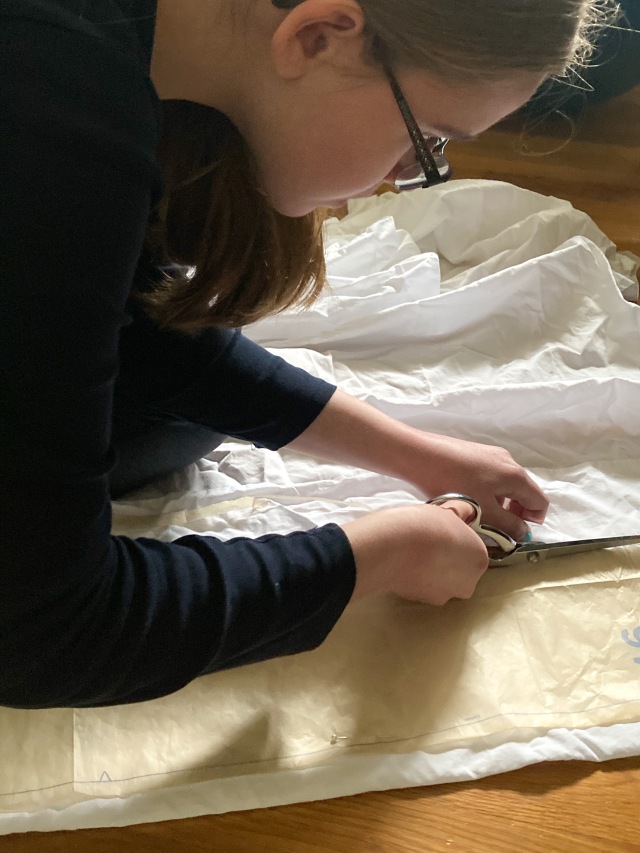Making Christine’s Dressing Gown For Under $10
“No, what I love best”, Lotte said “Is when I’m asleep in my bed, and the Angel of Music sings songs in my head”
Christine Daae, Andrew Lloyd Webber’s The Phantom of The Opera
Cue the organ overture and chandelier crash.
I’ve loved the costumes from The Phantom of The Opera ever since I saw the remastered version live when it came to Memphis a few years ago.
Remember live theatre? Good times!
A few months ago, I had the idea to make a version of the dressing gown that Christine Daae wears in Act 1 of Phantom. Why not infuse some drama into lounge wear?
Today, I’m going to share the longer than 15 second Instagram Reel version of how I made it, as well as how I was able to make it for less than $10 in total.
Be sure to follow me here and on Instagram @yarnbending to follow what I’m working on.
I originally planned to make this robe for myself, but after cutting out all of the pieces (according to the size that matched my measurements) and starting the bodice construction, I found out that it was just that much too small for a comfortable fit. Luckily, my 13 year old sister fit it perfectly, so it became her robe.

I primarily used view C of McCall’s #M7801 but with pieces 5 & 6 from view B for the shoulder flounce.
I paid $3.99 for the pattern in September (not the best price they’ve ever had, but still better than $22).
Some of you who follow my Instagram Stories may be wondering how I can afford to buy so many patterns, this is because of 2 rules that I always follow when it comes to pattern buying:
- I always buy my patterns directly from McCall’s and not from Joann, Hobby Lobby, or any other 3rd party.
- I never ever pay full price for patterns. I always wait for a sale.
The patterns always go on sale in September and about three other times a year, so throughout the year, I search the catalogs keep a list of all the patterns I want to buy along with their respective pattern numbers in an Excel spreadsheet. The individual price of patterns are typically $2.99-$3.99 each for McCalls and Butterick patterns and $4.99-$5-99 for Vogue patterns.
To give you an idea of how much money this can save you: during their New Year’s Sale, I bought six patterns and the total came to less than $20 (not including shipping). If I’d paid full price, it would’ve been over $150.

Next up: material.
At this point, you may be wondering how I was able to get fabric for $6.
The original robe on which this is based is made of brocade and layers of lace.
This is great for the stage where it can be dry-cleaned regularly, but not great for real life use. Brocade is hard to clean, not to mention expensive (polyester brocade starts at around $20 / yard).
Rather than use brocade, I chose to go with a significantly less expensive and easier to wash alternative: bed sheets.
Goodwill almost always has a selection of white flat sheets in a variety of sizes and materials. I selected a 100% cotton king size flat sheet that had a soft handle, since it would be next to the skin.
I ended up paying full price for it ($5) because Goodwill doesn’t give their student discount to high school students 🙁 .
After cutting out most of the pieces, I started wondering if the one sheet would be enough, so I went ahead and got another flat sheet this time in a full size, for $0.99.
Neither one of them had any significant staining, but I still washed both of the sheets with bleach to whiten and disinfect them.
I cut all of the main pieces cut from the king sized sheet and cut the ruffles for the skirt from the 2nd sheet.
“I got frills, they’re multiplying”
This robe has so many ruffles. A total of 6 yards (5 meters) of ruffles went into the bottom of this robe.
Construction:
I used a spool of white Coats & Clark polyester sewing thread that I already had in my sewing box for all of the seams.
Aside from the bodice and armholes, I constructed everything with French seaming, which was a bit of pain, but worth it.
I like to use this technique whenever possible because of the finished look it gives a and it was especially important for this project when it came to the skirt, due to the wrong side of the fabric being visible. I also think it helps the ruffles on the sleeves to stand out a bit and have some body.
The armhole seams were over-locked to prevent fraying.
Is it a Broadway costume? No, but I love the finished results and think it looks pretty good for $10. My sister is also thrilled with it and uses it daily.
Have you ever made a theatre inspired sewing project? What is your favorite theatre costume? Let me know in the comments!
//z-na.amazon-adsystem.com/widgets/onejs?MarketPlace=US&adInstanceId=9329922a-c11b-4a23-9c5c-b1baac90cb99This post first appeared on yarn-bending.com
Copyright 2021, all rights reserved.





